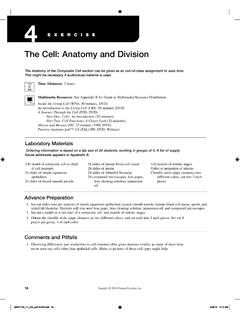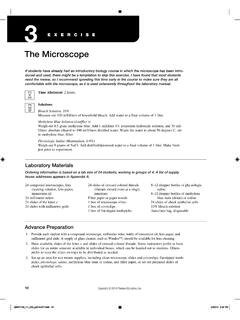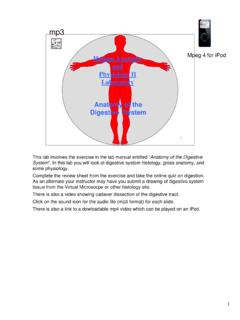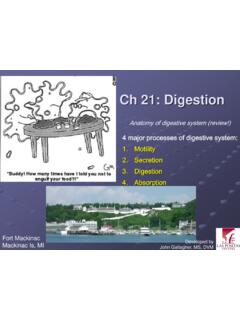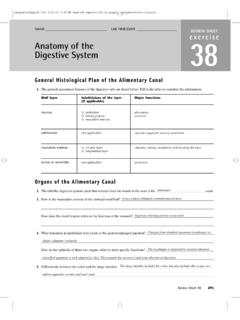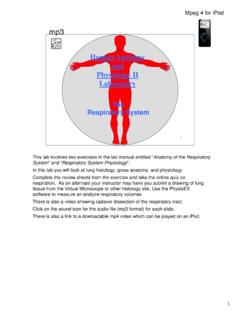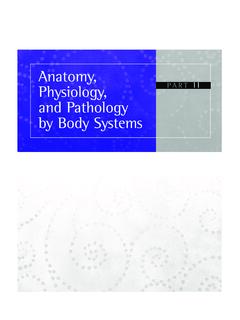Transcription of Laboratory Materials Advance Preparation
1 Copyright 2014 Pearson Education, Allotment: 1 hours (rat dissection: 1 hour; if performing reproductive system dissection, hour each for male and female; dissectible human torso model: hour).Multimedia Resources: See Appendix B for Guide to Multimedia Resource (FHS: 20 minutes, VHS, DVD, 3-year streaming webcast)Homeostasis: The Body in Balance (HRM: 26 minutes, VHS, DVD)Practice anatomy Lab (PAL) (PE: DVD, Website)Solutions:Bleach Solution, 10%Measure out 100 milliliters of household bleach. Add water to a final volume of 1 liter. Laboratory MaterialsOrdering information is based on a lab size of 24 students, working in groups of 4. A list of supply house addresses appears in Appendix Systems OverviewExErcisEDissectible human torso model or cadaver6 12 forceps6 12 scissors6 12 blunt probesDisposable gloves, soap, and sponges6 12 freshly killed or preserved ratsTwine or large dissecting pins6 12 dissecting traysLab disinfectant or 10% bleach solutionAdvance Preparation 1.
2 Make arrangements for appropriate storage and disposal of dissection Materials . Check with the Department of Health or the Department of Environmental Protection, or their counterparts, for state regulations. 2. Designate a disposal container for organic debris, set up a dishwashing area with hot soapy water and sponges, and provide lab disinfectant such as Wavicide-01 (Carolina) or bleach solution for washing down the lab benches. 3. Set out safety glasses and disposable gloves for dissection of freshly killed animals (to protect students from parasites) and for dissection of preserved animals. 4. Decide on the number of students in each dissecting group (a maximum of four is suggested, two is probably best).
3 Each dissecting group should have a dissecting pan, dissecting pins, scissors, blunt probe, forceps, twine, and a preserved or freshly killed rat. 5. Preserved rats are more convenient to use unless small mammal facilities are available. If live rats are used, they may be killed a half-hour or so prior to the lab by administering an overdose of ether or chloro-form. To do this, remove each rat from its cage and hold it firmly by the skin at the back of its neck. Put the rat in a container with cotton soaked in ether or chloroform. Seal the jar tightly and wait until the rat ceases to breathe. 6. Set out dissectible human torso models and a dissected human cadaver if 72/20/13 9:53 AM8 Exercise 2 Copyright 2014 Pearson Education, 2014 Pearson Education, Inc.
4 Comments and Pitfalls 1. Students may be overly enthusiastic when using the scalpel and cut away organs they are supposed to locate and identify. Therefore, use scissors to open the body. Have blunt probes available as the major dissecting tool. 2. Be sure the lab is well ventilated, and encourage students to take fresh air breaks if the preservative fumes are strong. If the dissection animal will be used only once, it can be rinsed to remove most of the excess preservative. 3. Organic debris may end up in the sinks, clogging the drains. Remind the students to dispose of all dissec-tion Materials in the designated container. 4. Inferior vena cava and aorta may be difficult to distinguish in uninjected to Pre-Lab Quiz (p.)
5 15) 1. The cell 2. c, organ 3. nervous 4. urinary 5. diaphragmAnswers to Activity QuestionsActivity 5: Examining the Human Torso Model ( pp. 22 23 ) 2. From top to bottom, the organs pointed out on the torso model are: brain, trachea, thyroid gland, lung, heart, diaphragm, liver, stomach, spleen, large intestine, greater omentum, small intestine 3. Dorsal body cavity: brain, spinal cord Thoracic cavity: aortic arch, bronchi, descending aorta (thoracic region), esophagus, heart, inferior vena cava, lungs, trachea Abdominopelvic cavity: adrenal gland, descending aorta (abdominal region), greater omentum, inferior vena cava, kidneys, large intestine, liver, mesentery, pancreas, rectum, small intestine, spleen, stomach, ureters, urinary bladder Note: The diaphragm separates the thoracic cavity from the abdominopelvic cavity.
6 Right Upper Quadrant: right adrenal gland, right kidney, large and small intestine, liver, mesentery, pancreas, stomach, right ureter Left Upper Quadrant: left adrenal gland, descending aorta, greater omentum, left kidney, large and small intestine, mesentery, pancreas, spleen, stomach, left ureter Right Lower Quadrant: large and small intestine, mesentery, rectum, right ureter, urinary bladder Left Lower Quadrant: descending aorta, greater omentum, large and small intestine, left ureter, urinary bladder 4. digestive : esophagus, liver, stomach, pancreas, small intestine, large instestine (including rectum) Urinary: kidneys, ureters, urinary bladder Cardiovascular: aortic arch, heart, descending aorta, inferior vena cava Endocrine: pancreas, adrenal gland, thyroid gland Reproductive: none Respiratory: lungs, bronchi, trachea Lymphatic/Immunity: spleen Nervous: brain, spinal 82/20/13 9:53 AM9 Exercise 2 Copyright 2014 Pearson Education, 2014 Pearson Education, to Group Challenge (p.)
7 24)Some possible answers to the questions are listed below. Student answers may Which is the odd organ ?Why is it the odd one out?StomachTeethSmall intestineOral cavityThe teeth are an accessory structure of the digestive system whereas the oral cavity, stomach, and small intestine are part of the digestive Which is the odd organ ?Why is it the odd one out?Thyroid glandThymusSpleenLymph nodesThe thyroid gland is not an organ of the lymphatic Which is the odd organ ?Why is it the odd one out?OvariesProstate glandUterusUterine tubesThe prostate gland is not a part of the female reproductive Which is the odd organ ?Why is it the odd one out?StomachSmall intestineEsophagusLarge intestineThe esophagus is in the thorax whereas the stomach, small intestine, and large intestine are in the abdominopelvic 92/20/13 9:53 AMCopyright 2014 Pearson Education, 1.
8 Use the key below to indicate the body systems that perform the following functions for the body; note that some body systems are used more than once. Then, circle the organ systems (in the key) that are present in all subdivisions of the ventral body : a. cardiovascular d. integumentary g. nervous j. skeletal b. digestive e. lymphatic/immunity h. reproductive k. urinary c. endocrine f. muscular i. respiratoryk; urinary 1. rids the body of nitrogen-containing wastesc; endocrine 2. is affected by removal of the thyroid glandj; skeletal 3. provides support and levers on which the muscular system actsa;cardiovascular 4.
9 Includes the hearth; reproductive 5. has a menstrual cycle in femalesd; integumentary 6. protects underlying organs from drying out and from mechanical damagee; lymphatic/immunity 7. protects the body; destroys bacteria and tumor cellsb; digestive 8. breaks down ingested food into its building blocksi; respiratory 9. removes carbon dioxide from the blooda; cardiovascular 10. delivers oxygen and nutrients to the tissuesf; muscular 11. moves the limbs; facilitates facial expressionk; urinary 12. conserves body water or eliminates excessesc; endocrine and h; reproductive 13. facilitate conception and childbearingc; endocrine 14.
10 Controls the body by means of chemical molecules called hormonesd; integumentary 15. is damaged when you cut your finger or get a severe sunburn 2. Using the above key, choose the organ system to which each of the following sets of organs or body structures ; lymphatic/immunity 1. thymus, spleen, lymphatic vesselsj; skeletal 2. bones, cartilages, tendonsc; endocrine 3. pancreas, pituitary, adrenalsi; respiratory 4. trachea, bronchi, lungsd; integumentary 5. epidermis, dermis, and cutaneous sense organsh; reproductive 6. testis, ductus deferens, urethrab; digestive 7. esophagus, large intestine, rectumf; muscular 8.

